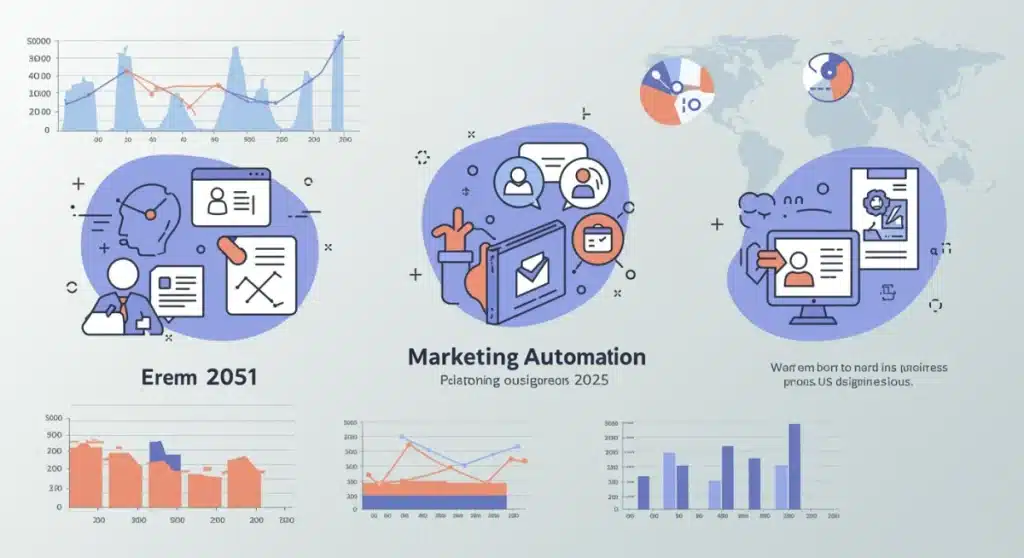Comparing Top 3 Marketing Automation Platforms for US Small Businesses in 2025

Comparing Top 3 Marketing Automation Platforms for US Small Businesses in 2025: A Data-Driven Analysis (COMPARISON/ANALYSIS) reveals that HubSpot, ActiveCampaign, and Mailchimp are set to lead, offering tailored solutions for diverse operational needs and growth trajectories.
As the digital landscape evolves, selecting the right marketing technology is paramount for sustained growth. This report provides a critical Comparing Top 3 Marketing Automation Platforms for US Small Businesses in 2025: A Data-Driven Analysis (COMPARISON/ANALYSIS), focusing on solutions best suited for the unique needs of US-based small businesses.
The Evolving Landscape of Marketing Automation in 2025
The marketing automation sector continues its rapid expansion, particularly for small businesses seeking to optimize operations and enhance customer engagement. In 2025, the demand for integrated, user-friendly, and cost-effective platforms has intensified, pushing providers to innovate at an unprecedented pace. This evolving environment necessitates a careful evaluation of available tools to ensure businesses invest in solutions that truly align with their strategic objectives.
The shift towards more personalized customer journeys and data-driven decision-making means that platforms offering advanced analytics and AI-powered insights are gaining significant traction. Small businesses are no longer looking for basic email schedulers; instead, they require comprehensive systems that can manage leads from initial contact through conversion and retention. The platforms under review reflect these critical market demands, offering robust features designed to empower smaller enterprises.
HubSpot: The All-in-One Growth Platform for Small Businesses
HubSpot remains a formidable contender, especially for small businesses prioritizing an integrated approach to marketing, sales, and customer service. Its comprehensive suite of tools, often referred to as a CRM platform, offers a seamless experience from lead capture to customer delight. For 2025, HubSpot has further refined its Starter and Professional tiers, making advanced automation features more accessible to budget-conscious small businesses.
Core Features and Integrations
HubSpot’s strength lies in its ability to consolidate various business functions into a single platform. This reduces the complexity often associated with managing multiple disparate tools, allowing small teams to operate more efficiently. The platform’s native integrations with popular business applications further extend its utility without requiring extensive custom development.
- Unified CRM: Centralizes customer data across marketing, sales, and service.
- Email Marketing & Automation: Sophisticated drag-and-drop email builder with advanced segmentation and workflow automation.
- Landing Page & Website Builder: Tools to create optimized landing pages and manage basic website content.
- Reporting & Analytics: Comprehensive dashboards providing insights into campaign performance and customer behavior.
Recent updates have focused on enhancing its AI-powered content creation tools and predictive lead scoring, offering small businesses a competitive edge in a crowded market. The platform’s extensive knowledge base and community support also provide invaluable resources for users navigating their automation journeys.
ActiveCampaign: Precision Automation and CRM for Growth
ActiveCampaign distinguishes itself through its exceptional automation capabilities and robust CRM functionalities, making it a top choice for small businesses seeking highly personalized customer experiences. In 2025, ActiveCampaign continues to lead in delivering intricate automation workflows that can adapt to individual customer behaviors, a crucial factor for maximizing conversion rates and customer loyalty.
Advanced Automation and Personalization
The platform’s visual automation builder allows users to create complex sequences based on a multitude of triggers and conditions, enabling truly dynamic customer journeys. This level of precision is particularly beneficial for businesses with diverse product lines or nuanced sales cycles.
- Deep Data Integrations: Connects with over 870 apps, allowing for comprehensive data utilization in automation.
- Site & Event Tracking: Monitors website visits and specific actions to trigger personalized communications.
- Predictive Sending: Utilizes machine learning to determine the optimal time to send emails for better engagement.
- SMS Marketing: Integrates SMS into automation workflows for multi-channel communication strategies.
ActiveCampaign’s focus on granular control and detailed analytics empowers small businesses to fine-tune their marketing efforts continuously. Its pricing structure is also highly scalable, allowing businesses to start small and expand their usage as their contact list grows, making it an attractive long-term solution.
Mailchimp: User-Friendly Entry Point with Expanding Capabilities
Long known for its user-friendly email marketing interface, Mailchimp has significantly expanded its offerings to become a more comprehensive marketing automation platform for small businesses. For 2025, Mailchimp has solidified its position as an accessible yet powerful tool, particularly for those new to marketing automation or businesses with a strong focus on email campaigns and basic CRM.
Ease of Use and Growing Feature Set
Mailchimp’s intuitive design makes it easy for small business owners and marketing teams to get started quickly, without a steep learning curve. While it began primarily as an email service provider, its recent enhancements include more robust CRM features, website building tools, and integrated advertising capabilities.
The platform now offers advanced segmentation options and multi-step customer journeys, allowing for more sophisticated automation than ever before. This evolution makes it a strong contender for businesses that want an all-in-one solution without the complexity or higher price point of some enterprise-level platforms.

Pricing and Scalability for Small Businesses
Mailchimp’s tiered pricing model, including a robust free plan for smaller lists, makes it highly attractive for startups and micro-businesses. As businesses grow, they can seamlessly upgrade to paid plans that unlock more advanced features and higher sending limits. This scalability ensures that Mailchimp can support businesses through various stages of their development, providing consistent value without requiring a complete platform migration as needs evolve. The platform’s ongoing integration with e-commerce solutions also makes it particularly appealing for online retailers looking to automate their sales and marketing efforts.
Comparative Analysis: Features, Pricing, and Scalability
When undertaking a Comparing Top 3 Marketing Automation Platforms for US Small Businesses in 2025: A Data-Driven Analysis (COMPARISON/ANALYSIS), it is crucial to examine the interplay of features, pricing, and scalability. Each platform offers distinct advantages that cater to different business models and growth stages. HubSpot, with its comprehensive CRM suite, provides an unparalleled all-in-one experience, ideal for businesses seeking a unified platform from the outset. Its pricing can be higher, but the value lies in consolidation and advanced features that eliminate the need for multiple subscriptions.
ActiveCampaign excels in its depth of automation and personalization. For businesses with complex customer journeys or those heavily reliant on behavioral triggers, ActiveCampaign offers the flexibility and power to execute highly targeted campaigns. Its pricing scales with contact volume and feature sets, offering good value for advanced users. Mailchimp, on the other hand, stands out for its ease of use and affordability, especially for businesses primarily focused on email marketing and looking for a gentle entry into automation. Its expanding feature set makes it increasingly competitive, though its CRM capabilities might not be as exhaustive as HubSpot’s or ActiveCampaign’s.
The choice often comes down to a business’s current needs and future aspirations. A startup focused on rapid email list growth might find Mailchimp’s free tier and intuitive interface perfect. A growing business with an established sales team and complex lead nurturing processes might gravitate towards HubSpot’s integrated CRM. Meanwhile, a company prioritizing hyper-personalization and intricate automation sequences would likely find ActiveCampaign to be the most suitable fit.
Choosing the Right Platform: Key Considerations for 2025
Selecting the optimal marketing automation platform in 2025 requires a strategic approach, especially for US small businesses navigating a competitive digital landscape. Beyond the core features, several critical factors should influence the decision-making process. First, consider your team’s technical proficiency. A platform with a steep learning curve can negate its advanced capabilities if your team lacks the skills or time to master it. User-friendly interfaces, like those offered by Mailchimp, can accelerate adoption and time-to-value for smaller teams.
Second, evaluate the platform’s integration ecosystem. Your chosen solution should seamlessly connect with existing tools, such as your e-commerce platform, accounting software, or customer support system. This interoperability is vital for creating a cohesive data flow and avoiding data silos. HubSpot, for instance, is built around robust internal integrations, while ActiveCampaign boasts an extensive marketplace of third-party connectors.
Finally, assess the platform’s customer support and community resources. Even the most intuitive software can present challenges, and reliable support is invaluable. Look for providers offering comprehensive documentation, responsive customer service, and active user communities that can provide peer-to-peer assistance. The long-term success of your marketing automation strategy heavily relies on the ability to troubleshoot issues and continuously learn from available resources. These considerations, combined with a thorough feature and pricing analysis, will guide small businesses toward the most effective marketing automation investment for 2025.
| Platform | Key Strength for Small Businesses |
|---|---|
| HubSpot | All-in-one CRM with integrated marketing, sales, and service tools. |
| ActiveCampaign | Advanced automation and deep personalization capabilities for complex journeys. |
| Mailchimp | User-friendly interface and affordable entry point for email-centric automation. |
| Key Trend for 2025 | Increased demand for AI-powered features and seamless integrations. |
Frequently Asked Questions About Marketing Automation Platforms
Marketing automation uses software to automate repetitive marketing tasks such as email campaigns, social media posts, and ad campaigns. For small businesses in 2025, it’s crucial for efficiency, personalized customer engagement, and scaling operations without increasing manual labor, leading to better ROI.
HubSpot typically offers higher-tier pricing for its comprehensive suite. ActiveCampaign scales based on contact volume and features, providing flexibility for growing lists. Mailchimp is known for its competitive pricing, including a robust free plan, making it very accessible for startups and smaller budgets.
While all three offer e-commerce integrations, ActiveCampaign’s deep automation and personalization can be highly effective for abandoned cart sequences and post-purchase flows. Mailchimp also provides strong e-commerce specific features, especially for businesses using platforms like Shopify or WooCommerce.
HubSpot is itself a powerful CRM, so integration is seamless. ActiveCampaign offers extensive integrations with hundreds of third-party CRMs. Mailchimp also provides various integration options, though its native CRM capabilities are more foundational compared to the others.
Mailchimp is generally considered the easiest to learn due to its intuitive interface. ActiveCampaign has a moderate learning curve due to its advanced features. HubSpot, while comprehensive, can have a steeper learning curve initially, but its unified approach simplifies long-term management.
Looking Ahead: Strategic Implications for Small Business Growth
The ongoing evolution of marketing automation platforms signals a critical juncture for US small businesses. The choices made in 2025 regarding these technologies will significantly impact their ability to compete, scale, and thrive in an increasingly digital-first economy. Businesses that strategically adopt platforms offering robust AI capabilities, seamless integration, and scalable pricing models are poised for sustained success. Expect further innovations in predictive analytics and hyper-personalization, driving even greater demand for sophisticated yet accessible automation tools. The landscape will continue to favor platforms that offer a unified approach to customer engagement, reducing operational silos and empowering small teams to achieve more with fewer resources. Monitoring these developments will be key for staying ahead.





